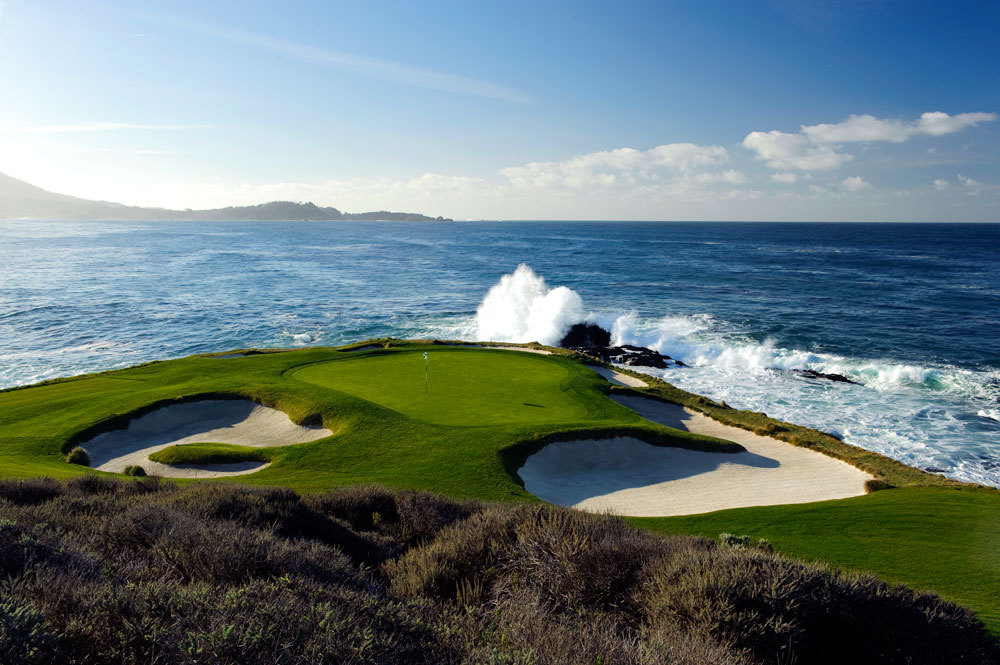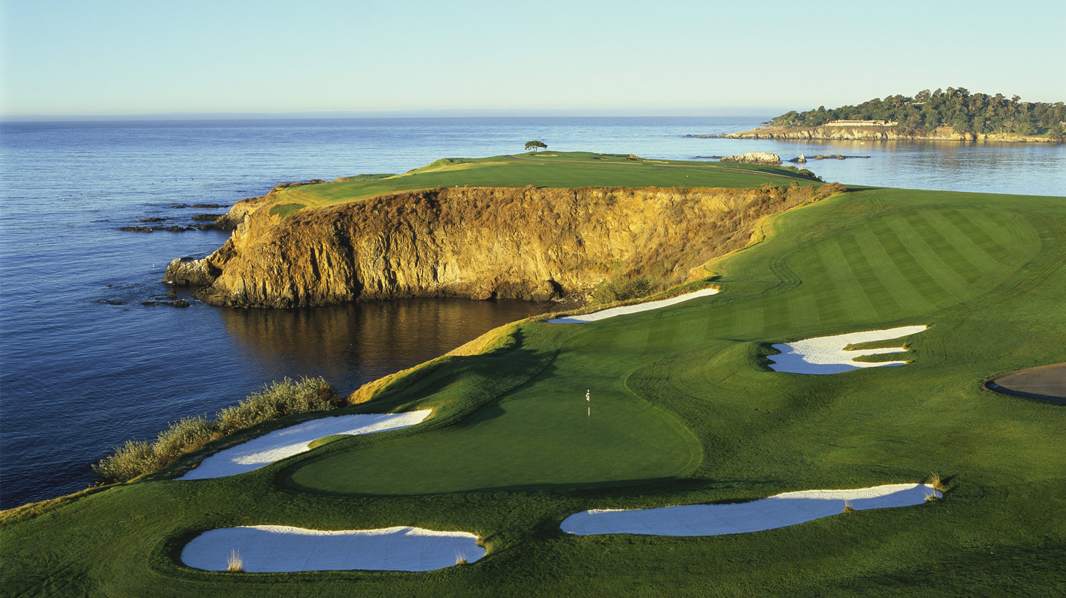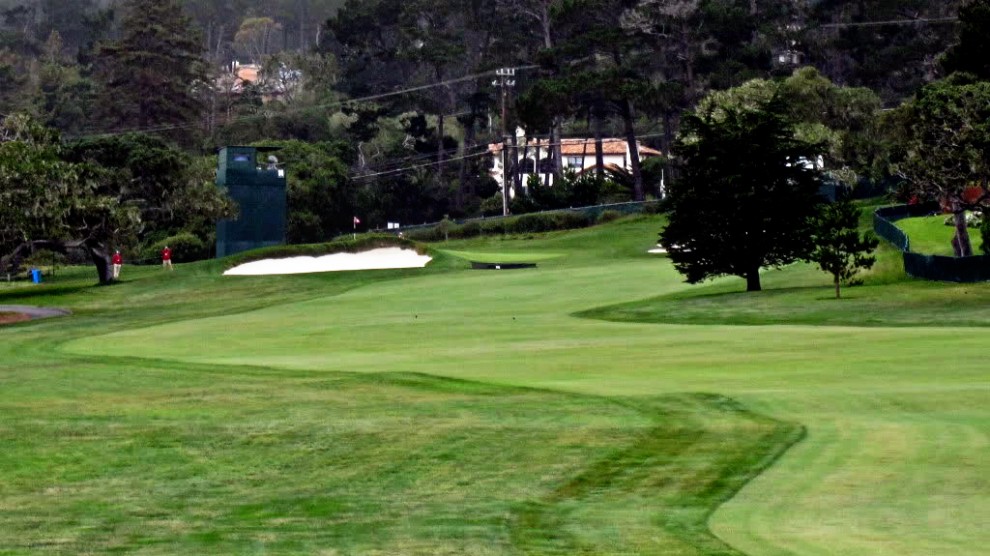This week the PGA Tour finds itself at one of the most iconic courses in the world -- Pebble Beach Golf Links -- for the AT&T Pebble Beach Pro-Am. For years, Pebble Beach has been the gold standard of public access golf in the United States, consistently ranked No. 1 in all major publications’ list of best public courses in the U.S.
As with many iconic courses that have stood the test of time and technology, the course has undergone many facelifts and alterations from its original form but has never lost its essence: a multitude of ‘signature’ holes with sweeping panoramic views of the Monterey Peninsula. No one argues with the sheer awesomeness of holes 4, 5, 6-10 (above Carmel Bay), 17 and 18 -- it’s the inland holes that only the nitpickiest of golfers quibble with.
The tournament is played across Pebble Beach Golf Links, Spyglass Hill Golf Course and Monterey Peninsula Country Club (Shore Course) for the first three rounds with a 54-hole cut for low 60 scorers plus any ties. From a course perspective, this matters because they keep the pin placements the same on each course for the first three days. In doing so, by the third day each course is sure to have a few pock marks around the cups that make putting slightly little more hazardous.
Pebble Beach Golf Links architecture and history
In the early 20th century, environmental conservationist and developer Samuel F.B. Morse was tasked with making the Pebble Beach-area attractive enough for real estate investment. His grandiose idea was to create a one-of-a-kind golf course with unsurpassed scenic beauty and an element of difficulty that would always be challenging. Because Morse was in the business of liquidation at the time, he needed to keep cost low so he literally hired a couple of amateurs to design and build the golf course: Jack Neville (a five-time champion of the California State Amateur championship) and Douglas Grant (a medalist in the California Amateur in 1917-19).
The course opened for play in February 1919 with the most famous quote about the course’s design provided by Jack Neville to the San Francisco Chronicle in 1972: “It was all there in plain sight. Very little clearing was necessary. The big thing, naturally, was to get as many holes as possible along the bay. It took a little imagination, but not much. Years before it was built, I could see this place as a golf links. Nature had intended it to be nothing else. All we did was cut away a few trees, install a few sprinklers, and sow a little seed.”
They accomplished this routing wizardry with a “figure 8” layout that still exists today. Though the design remained constant, those early years saw frequent and significant refinements as owner Samuel F.B. Morse brought in other architects to perfect the course as shown in the table.
| ARCHITECT | YEAR | CHANGES |
|---|---|---|
| Harold Sampson (assisted by Arthur Vincent) | 1919 | Improved the turf and playability of the course, including rebuilding a few greens. |
| William Herbert Fowler | 1922 | Transformed the 18th hole from a meek 379-yard par 4 into a 543-yard behemoth that can only be held in two shots by the best pros and is generally considered the best closing hole in golf. |
| H. Chandler Egan (assisted by Robert Hunter) | 1929 | Re-shaped and re-bunkered each green in preparation for the 1929 U.S. Amateur. They moved the 1st tee to create today’s dog-leg opening hole, reconfigured the 10th hole to move the 9th green to the coastline, added length to the 2nd and 14th holes, and moved the 16th green to a natural depression behind a grove of trees, extending the hole more than 100 yards. |
| Jack Nicklaus | 1998 | Designed the new 5th hole on a parcel of prime oceanfront land that Pebble Beach Company had wanted to re-acquire for 80 years. |
| Arnold Palmer | 1999-2015 | 1st, 2nd and 15th greens were rebuilt to USGA specifications. Several bunkers were added and reshaped, most notably to holes 1, 2, 4, 6, 15 and 18, and trees were planted to replace key trees that had died along the 90-year-old routing—including placing an 85-foot tall cypress near the front of the 18th green. Additional preparations are made for the 2010 U.S. Open: four greens and 16 bunkers are rebuilt, altered or installed; 11 tees benefit from enhancements; six holes see the addition or adjustment of trees; and the total length of the course is extended to 7,040 yards. And most recently restoring the 17th green and bunkers to former glory and size. |
As one of the shortest courses on the PGA Tour, it’s natural defense is weather (wind off the adjacent Pacific Ocean), bunkers (117 of them to be exact), and the smallest greens on Tour (averaging just 3,500 square feet). Professionals love this because hitting those tiny greens in potentially windy conditions places a premium on great ball-striking while controlling trajectory and spin. This is only magnified 10x by the USGA in years Pebble hosts the U.S. Open when the fairways are pinched, rough is grown to spaghetti-length, and the greens are double-cut and rolled to polished marble speeds.
Additionally, you could argue that if a modern architect were given the same piece of land today they would create a vastly different type of resort course better suited to the high quantity of rounds by well-heeled high-handicappers. For example, an iconic hole like hole 6 with its dramatic elevation changes from tee to fairway to green would probably be softened in the name of “playability." Or there wouldn’t been as many forced carries and there would certainly be additional bailout areas.

Holes to Watch
Arguably the best stretch of seaside holes in the world, holes 6-10 are the best on the property. With holes 8, 9, and 10 having an above par scoring average.
Hole 6 - A slight dogleg right, one of a few holes that potentially requires a semi-blind carry across an ocean chasm to a landing area that narrows toward the green. Made trickier by the fact players need to stay left away from the ocean but can’t see a number of bunkers waiting for a shot too far left. The optimum placement for the tee shot is left-center of the fairway. Your second shot must carry the steep slope, but beware of the bunkers on the left.
Hole 7 - One of the most picturesque one shot holes in all of golf. Somewhat similar to the Postage Stamp green of hole 8 at Royal Troon (only 123 yards), this hole is perched atop a bluff only 106 yards from the green. Club selection is key. Wind strength and direction requires anything from an easy lob wedge to a knock-down mid-iron.

Hole 8 - A wide fairway awaits, but don’t hit it too far as it narrows at the end...towards the ocean cliff. Pros will hit a long iron or hybrid and then have a middle iron shot across a deep oceanic chasm to a green severely sloped from back to front.
Hole 9 - A long par 4 that begs the players to stay safe away from the ocean right but left are bunkers and sidehill lies aplenty as the fairway slopes from left to right. With the ball potentially below the players’ feet on approach, the ocean looms for any mishit fades. Additionally, there is a deep-bunkered gully left and short that will punish a timid approach.
Hole 10 - Another medium-length par 4 with the ocean running down the right side. A strong tee shot to the left center of this sloping fairway will leave players with a medium iron shot. Bunkers left and long will capture errant shots. The green slopes from left to right keeping the stroke average above par.

